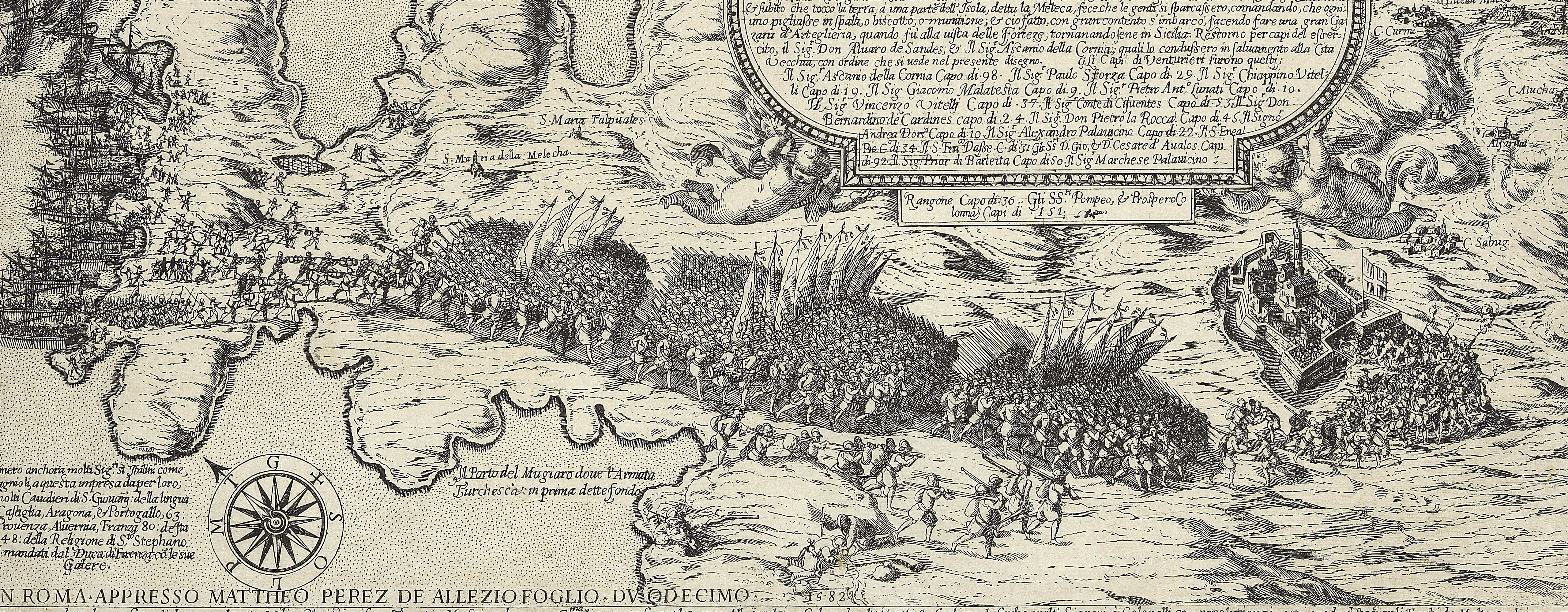
Ottoman-Habsburg Wars (1521-1791)
Images from eight wars fought between 1570 and 1718
View of Vienna, 1532 (Vienna, Austria) 48°12ʹ30ʺN 16°22ʹ19ʺE
dated 1532Etching with engraving; printed on paper; mounted on paper (Mount Type B); gilt edges to bottom and right | 26.1 x 34.0 cm (image of view) | RCIN 721005
A middle oblique view of the Turkish army, led by Suleiman the Magnificent (6 November 1494-7 September 1566) and the Imperial army, commanded by Charles V (24 February 1500-21 September 1558), Holy Roman Emperor, with his brother Ferdinand, surrounding Vienna in September 1532. The Ottoman Empire (1500-1606): The Vienna Campaign (1529-33). Oriented with north (not specified) to top.
In 1532 Suleiman led another invasion into Austria but his advance towards Vienna, in a second attempt to take it following the failed siege of 1529, was delayed by the determined Habsburg defence of the town of Güns (Kószeg) against Suleiman’s army, some 100 km to the south of Vienna.
Because the distances are so foreshortened in this view it is not possible to determine the distance of the Turkish troops from Vienna. It is probable that they are, in fact, several kilometres away, coming from Kószeg in the south. The place-name ‘PRVGETTI’ which is engraved near the Turkish camp is possibly present-day Bruck an der Leitha (48°01ʹ00ʺN 16°46ʹ00ʺE) which has the road to Budapest running through it (note the troops on this road, which stands on the River Leitha (the ‘LEYTA F[iume]’) on the view.
This view shows Turkish light cavalry demonstrating against Vienna, faced by the army of Charles V on the opposite bank of the Danube. The Turkish camp is shown in the foreground, protected by a line of gabions interspaced with cannon, resting on their limbers. A barrel of gunpowder appears to have blown up, bottom right. The Turkish emblem of the crescent flies from the pennants on top of the tents. Infantry and cavalry appear to be armed with pikes. Suleiman's expedition was a failure.
The Imperial standard with the double-headed eagle flies from the castle in Vienna while, on the opposite bank of the Danube, the Imperial army is protected by an encirclement of gabions and cannon.
The text to the map notes that it is a true representation of the area of Austria-Hungary surrounding Vienna, and the rivers, bridges, cities and castles. The surrounding towns of Ratisbona (Regensburg 49°02ʹ04ʺN 12°07ʹ09ʺE), Patavia (Passau 48°33ʹ59ʺN 13°25ʹ52ʺE), Krems (Krems an der Donau 48°24ʹ33ʺN 15°36ʹ51ʺN), Lintz (Linz 48°18ʹ23ʺN 14°17ʹ10ʺE), Ens (Enns 48°12ʹ48ʺN 14°28ʹ34ʺE), Hanpurg (Hainburg an der Donau 48°08ʹ47ʺN 16°56ʹ42ʺE), Strigonia (Esztergom) and Buda, are shown. The view therefore covers an area of about 340 miles from NW to SE, although the principal focus is the conflict at Vienna. Charles had arrived outside Vienna on 23 September, but the Imperial troops refused to cross the Hungarian frontier and he left the area on 4 October without having given any order for a decisive battle to be fought and the Ottomans retreated.
A variant state, without the Salamanca imprint, and lacking the final line of the text: ‘CON GRATIA, ET, PRIVILEGYO’ is in the Franco Novacco Collection, Newberry Library, Chicago (Novacco 2F 24).
Agostino dei Musi (c. 1490-after 1536) (engraver) [bottom right, engraved on a boulder:] 1532 /·A·V·
Antonio Salamanca (1500-62) (publisher) [bottom right:] Ant. sal. exc.
Subject(s)
Army-Ottoman EmpireArmy-ImperialWatermark: Rampant stag in a shield
Condition: cropped to edge of image, the bottom margin removed except for text; impressions from the mounts of items which were kept above and below this map/print in a former sequence are present on the recto and verso. Verso: some offsetting: ‘MODERNA’ and two other indistinct words in upper case letters
26.1 x 34.0 cm (image of view)
7.7 x 20.3 cm (image of text)
48.9 x 39.0 cm (sheet)
Printed title:
VERISSIMO RETRATTO DELLI SITI ET LVOGHI DELLE PARTE DAVSTRIA, ET / VNGARIA, CONLI NOMI DELLI FIVMI, PONTI, CITTA, ET, CASTELLE, DOVE / NELANNO⋅MDXXXII⋅DEL MESE DI SEPTEMBRE, SE TROVAVA LO / INVITTISSIMO CARLO⋅V⋅IMPERATORE DE CHRISTIANI, COL / SERMO FERDINANDO SVO FRATELLO RE DE ROMANI, ET LO ILLMO, ET / RMO HYPPOIITO CARLE DE MEDICI, LEGATO DELLA SEDE APLICA / CON⋅CM/XX⋅ FANTI, ET⋅M/XXV⋅ CAVALLI CHRISTIANI, ELETTISSIMI. / ARMATI PER ANDARE, A, DAR LA BATTAGLIA, A, SOLYMANO / RE DE TVRCHI, IL QVALE PARTITO DA CONSTANTINOPOLI, ET / DALLI REGNI SVI CON INNVMERABILE EXERCITO DA PIEDE, ET DA / CAVALLO ERA VENVTO AD ASSALTARE CHRISTIANI, PER PILGLIARE / LALEMANIA, E, OCVPARE, LA SEDIA, INPERIALE, ET, CHRISTIANITA, / CON GRATIA, ET, PRIVILEGYO. [in a panel, below map]
Annotations:
George III heading: Austria Sep. 1532.
Other annotations: (Recto) [on mount, bottom right, black pencil:] B.xiv. No. 419; [on mount, bottom left, black pencil, erased:] I/[?]. (Verso) [on mount, bottom left, red pencil:] ¼.
George III catalogue entry:
Austria. Retratto delli siti et luoghi delle parte d’Austria et Ungaria, con li nomi delli Fiumi, Ponti, Citta, et Castelle, dove nel anno 1532 del mese di Septembre, se trovava Carlo V Imp. col Ferdinando suo Fretello Re de Romani, et Hyppolito Car.le de Medici, legato della Sede Ap.lica con 1130 fanti et 1035 cavalli Christiani elettissimi armati, per andare a dar la battaglia a Solymano Re de Turchi: da A.V. 1532. Ant. Sal. exc.
Subject(s)
Vienna, Austria (48°12ʹ30ʺN 16°22ʹ19ʺE)
Bibliographic reference(s)
M. McDonald, The Print Collection of Cassiano dal Pozzo. Part II, Architecture, Topography and Military Maps, 3 vols, London 2019, cat. no. 2640
J.D.Tracy, Emperor Charles V, impresario of war: Campaign strategy, international finance, and domestic politics, Cambridge 2002, p.141
Page revisions
25 May 2024
Current version
-






